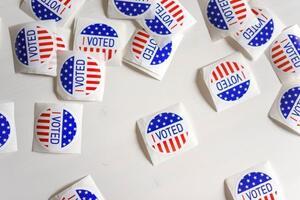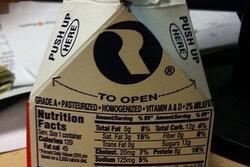Voting: Still a Right, Right?
Typically, walking through the doors of my high school gym brings on a feeling of dread, accompanied by the smell of body odor and wet paint. When I walked into the gym this past November, however, the only thing I felt was excitement. On the day of the 2018 Midterm Elections, I had decided to spend my Tuesday afternoon and evening as an election official, helping voters register, cast ballots, and, most importantly, go home with an “I Voted!” sticker proudly affixed to their shirts.
As I strolled into the gym-turned-polling-place, I caught sight of a disappointed-looking man trudging towards the exit. An equally saddened-looking woman with an election official badge trailed behind him. When I approached her, she informed me the man didn’t possess an acceptable photo ID, and therefore couldn’t vote. “It’s really a shame,” she said, and then went to go help at the voter registration table. I remained frozen, staring at the man’s retreating figure in the parking lot. He had attempted to act as a fully engaged, politically active citizen, and we had turned him down. But why? What was the point?
The first time I learned about Voter ID requirements was during my freshman year U.S. history class. At the time, we were studying the disenfranchisement of Black voters in the South during Reconstruction. My teacher invited us to consider how this history paralleled the controversial Wisconsin legislation that was in place at the time. Instituted by the Republican-controlled Wisconsin state legislature in 2011, the Voter ID law was ostensibly passed to reduce voter fraud. The law required all voters to demonstrate an approved type of photo identification before they could cast a ballot for an election. After bouncing around the court system for more than four years, the law survived a Supreme Court challenge by the ACLU and remains in full effect today.
While some Wisconsin legislators discuss voter fraud as if it’s pernicious and widespread, their claims remain unfounded. One study, released by Columbia University, concluded that most incidences of suspected voter fraud are actually election officials’ errors or defeated politicians’ false assertions, but purposeful fraud is extremely rare. Rather than addressing non-existent fraud, the Voter ID laws in Wisconsin (and those in Kansas, Mississippi, Tennessee, and Virginia, to name a few) have made headlines because of their devastating effects on minority turnout. While the majority of voters have driver’s licenses or passport on hand, poor and minority voters are significantly less likely to have an acceptable form of photo ID. They are also less likely to have access to a local DMV to pick up free photo IDs because of childcare or transportation related limitations.
With these examples, my history teacher drew an alarmingly accurate connection between Voter ID laws and the voting restrictions in place during Reconstruction. Nineteenth-century practices, such as literacy tests, poll taxes, residency requirements, and the physical intimidation of Black voters ensured that the needs of minority communities would never be addressed by the government. Although America entered a golden age of voting expansion with the Voting Rights Act of 1965 and the 24th amendment, we seem to be slipping back into a period of voter suppression and disenfranchisement as state legislatures approve more voting restrictions every year.
These restrictions extend far beyond Voter ID laws. As a disproportionate percentage of minority workers are employed in low-paying jobs, these workers are less likely to be able to take time off of work to vote on a Tuesday. In spite of (or, perhaps, because of) this situation, state legislatures across the country have passed laws restricting the hours and locations of early voting sites, prohibiting minorities and the poor from exercising their right to vote. Many legislatures have also conducted massive voter purges, which Supreme Court Justice Sonia Sotomayor asserts “disenfranchise low-income and minority voters.” Additional, clearly discriminatory voting barriers implemented across the US include moving or closing polling places (sometimes without prior notice), preventing felons from voting, purposefully disseminating false information, constructing police roadblocks near voting sites, and only offering ballots in English.
While I sat behind a poll book on November 8th, checking off voters’ names and handing out ballots, I wondered how many eligible voters weren’t going to come to my table that night, thwarted by the endless hurdles placed in front of the ballot. As I watched members of my community, including my parents, exercise their most fundamental political right, I realized that I will never have to face the voting obstacles that ceaselessly frustrate my minority counterparts. Even if I were to misplace or have an expired driver’s license or passport, I would still have the time and resources to acquire a state ID card from the DMV before Voting Day. I will most likely always have the necessary transportation and childcare to go to the polls on a Tuesday. Police roadblocks won’t deter me, and it is unlikely that polling locations will be closed in my area.
This disparity has severe and sweeping consequences. Numerous critical elections have yielded ambiguous results as a result of voter suppression practices, most frequently regarding the minority vote. In the 2016 Presidential Election, for example, Hillary Clinton lost Wisconsin by 23,000 votes. Post-election polling found that up to 45,000 voters were dissuaded from voting by the photo ID law, at least half of whom were located in heavily Democratic and minority areas, such as Madison and Milwaukee. When the thousands of voters were unable to cast ballots for Clinton, they lost the ability to cast a vote for a politician who would defend not only their voting rights, but their right to affordable health care, a reformed criminal justice system, paid family leave, and an increased minimum wage. When this situation is replicated time and time again, from Florida in 2000 to Georgia in 2018, all Americans face serious consequences, no matter the color of our skin or the amount of money in our bank accounts.
When the right to vote isn’t guaranteed for everyone, democracy isn’t guaranteed to anyone.
This piece was written as part of JWA’s Rising Voices Fellowship.








Wow!
well said. recognizing that many people have numerous obstacles to overcome in registering to vote and getting to the polls reveals a compassion and empathy that is too often lacking in our legislators.